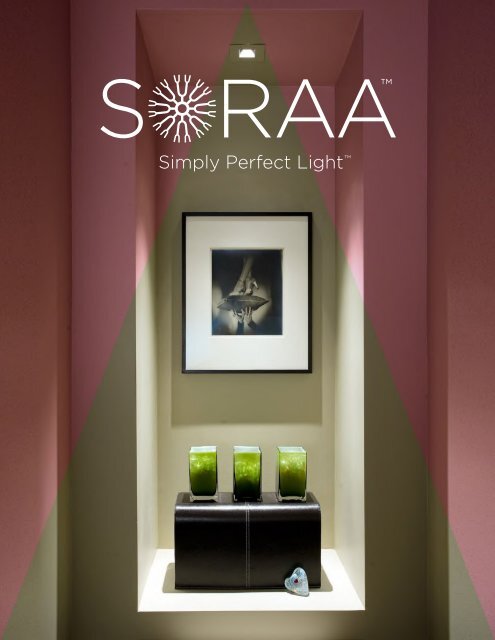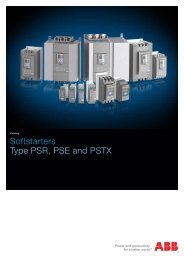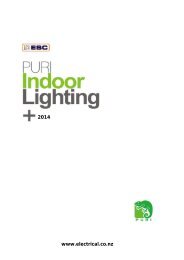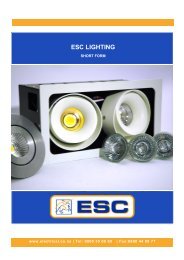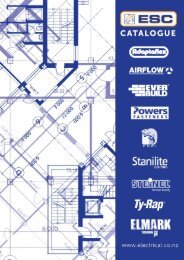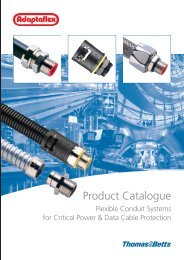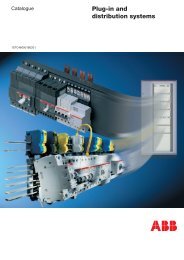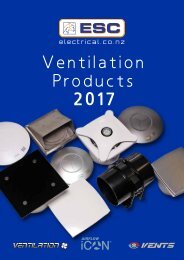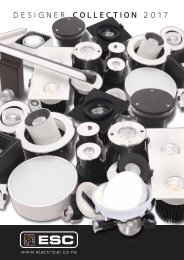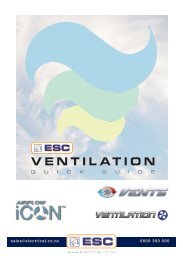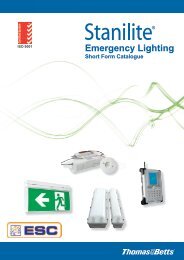Soraa_Summary_Brochure_4.9
You also want an ePaper? Increase the reach of your titles
YUMPU automatically turns print PDFs into web optimized ePapers that Google loves.
A Simply Perfect LED MR16<br />
THE SORAA MR16 LAMP offers better light quality<br />
than halogen, has a single light source, needs no fan<br />
for cooling, has the highest compatibility with<br />
dimmers and transformers, and fits all MR16 fixtures.<br />
Perfect Light<br />
<strong>Soraa</strong> LED lamps provide perfect illumination for you<br />
and your environment.<br />
Halogen Equivalent Performance<br />
The light output of <strong>Soraa</strong> lamps look as good or, in<br />
some cases, better than standard halogen lamps,<br />
offering better beams, patterns, and shadowing than<br />
halogens.<br />
Perfect Beam Profile<br />
Baffles, filters, and lensing are need to control the<br />
beam and unwanted light spill of halogen lamps.<br />
<strong>Soraa</strong> lamps have a perfect beam profile and do not<br />
require additional accessories to control the light.<br />
Color Matching<br />
Similar to halogens, <strong>Soraa</strong> lamps emit a broad continuous<br />
spectrum. They render more of the color<br />
wavelengths than other LED lamps, making colors<br />
look more vivid.<br />
Color Consistency<br />
Spectral output is consistent from <strong>Soraa</strong> lamp to<br />
<strong>Soraa</strong> lamp. The color is controlled tightly, within a<br />
3-Step MacAdam’s Ellipse so that objects are illuminated<br />
consistently.<br />
Color Over Angle<br />
<strong>Soraa</strong> lamps maintain color control for uniform color<br />
rendering over all angular beam profiles.<br />
Cover Photo: Randall Whitehead
THE STORY OF GaN-ON-GaN<br />
Transmission electron microscope<br />
images show multiple dislocations<br />
in conventional gallium nitride<br />
material (left) and dislocation-free<br />
<strong>Soraa</strong> GaN-on-GaN crystals (left).<br />
In 2007, <strong>Soraa</strong>’s founders made a bet on an LED<br />
technology platform completely different than<br />
current industry practice, a technology most industry<br />
experts at the time considered to be impossible to<br />
execute.<br />
They bet on Gallium Nitride substrates for LEDs, or<br />
“GaN-on-GaN” LEDs.<br />
Until <strong>Soraa</strong>, all LEDs worldwide were made of GaN<br />
crystals grown onto a dissimilar base, usually a sapphire<br />
or silicon carbide substrate.<br />
<strong>Soraa</strong> bet that GaN-on-GaN LEDs would produce<br />
more light and be more cost-effective than any of<br />
these other combinations. This belief ran contrary to<br />
every trend in the LED industry. But <strong>Soraa</strong>’s worldclass<br />
team had the credentials to take that bet and<br />
beat the odds:<br />
• Dr. Shuji Nakamura, inventor of the blue laser<br />
and the blue LED<br />
• Dr. Steven DenBaars, founder of Nitres<br />
• Dr. James Speck of the University of California,<br />
Santa Barbara’s College of Engineering<br />
How Does Crystal Structure Affect LED<br />
Performance?<br />
The fundamentally different crystal structure of <strong>Soraa</strong><br />
LEDS produced by GaN-on-GaN technology allows<br />
the LED to operate at much higher levels and generate<br />
more light per unit of LED material than any other<br />
LED. Also, all other LEDs are based on dissimilar<br />
crystal structures, which result in dislocations that<br />
adversely affect performance. GaN-on-GaN crystals<br />
are up to a thousand times more precise than any<br />
other LED crystal.<br />
Perfect crystals mean perfect light.<br />
The bet paid off. Today, only <strong>Soraa</strong> uses perfect GaNon-GaN<br />
crystals for its LED lighting products.
BENEFITS OF SORAA’S SOLUTION<br />
Perfect Fit<br />
No more guess work. <strong>Soraa</strong> lamps fit and work safely<br />
wherever they’re installed. <strong>Soraa</strong> lamps conform to<br />
the ANSI standard, so they fit standard lighting fixtures<br />
when used as specified.<br />
Performance<br />
No more blinking, buzzing, noisy LED lamps or ones<br />
that simply just don’t turn on. <strong>Soraa</strong> lamps turn on<br />
and operate properly with both magnetic and electronic<br />
transformers.<br />
Class 1 & Class 2 Low Voltage Transformers<br />
Don’t know what kind of transformer you have? It<br />
doesn’t matter. While most LED lamps are designed<br />
to work only with Class 2 systems, <strong>Soraa</strong> lamps are<br />
UL listed for both NEC low voltage Class 1 and<br />
Class 2 transformers, so you can use them with any<br />
low voltage UL listed system.<br />
UL Safe<br />
Many MR16 LED lamps are only R-UL rated, which<br />
means that they are UL recognized as a component<br />
but are not UL listed. The R-UL label means additional<br />
UL certification is required for installation in a UL<br />
listed fixture. <strong>Soraa</strong> lamps are fully UL listed, so you<br />
can trust them to work safely as a retrofit lamp in UL<br />
listed fixtures.<br />
Dimming<br />
Experience perfected LED dimming. Unlike some<br />
competitive LEDs, <strong>Soraa</strong> lamps work properly with<br />
many commonly installed leading-edge and trailingedge<br />
dimmers.<br />
Perfect Form<br />
The <strong>Soraa</strong> lamp takes advantage of the compact<br />
MR16 form factor, while greatly improving performance<br />
over halogen lamps.<br />
Single Source<br />
A high lumen density enables more light output from<br />
a single, small source, giving you more flexibility to<br />
design and control the lighting environment with a<br />
single visible point of light.<br />
More Natural Light<br />
<strong>Soraa</strong> lamps give you halogen level performance<br />
from a single LED light source. This replicates halogen<br />
illumination, with one color and one shadow.<br />
Elegant Design<br />
The thermally optimized heat sink is intricately designed<br />
with only 6 parts.<br />
Lightweight<br />
<strong>Soraa</strong> lamps are the same weight as standard halogen<br />
lamps, so they won’t add weight to the lighting<br />
system.<br />
Energy Efficient<br />
Lower energy use will shrink your utility bill – <strong>Soraa</strong><br />
lamps use about 75% less energy than halogen lamps.<br />
They also reduce maintenance and waste because<br />
they last more than 10 times longer than typical halogen<br />
lamps.<br />
The <strong>Soraa</strong> lamp’s single source (left) eliminates multiple<br />
shadows and colors typical of multi-source LEDs.
What Makes <strong>Soraa</strong> Lamps Different?<br />
Why Are Single Source LEDs Better?<br />
A single LED source ensures crisp single shadows<br />
with only one color. Lamps with multiple LED sources<br />
project multiple shadows with multiple colors, yielding<br />
less attractive results on objects being displayed.<br />
Even halogen MR16 lamps, because they have multifaceted<br />
reflectors, do not project shadows as crisply<br />
as single LED lamps. <strong>Soraa</strong>’s LED MR16 single source<br />
yields a single crisp shadow and color..<br />
Halogen lamp<br />
Typical LED lamp<br />
produces multiple<br />
shadows and colors<br />
Visible Spectrum<br />
<strong>Soraa</strong> lamp has crisp<br />
shadow definition<br />
<strong>Soraa</strong> Vivid 95 CRI Comparative Spectral Signature<br />
Why Don’t LED Lamps Render Objects with<br />
the Same Colors as Halogens?<br />
There are several reasons for this. Other LED lamps<br />
use a blue LED emitter with various phosphors to<br />
make the LED emit white light. The resulting LED<br />
spectrum does not exactly match the halogen black<br />
body curve for the visible light spectrum. It has a high<br />
blue spike and is missing part of the spectrum in violet<br />
and cyan. LED lamps also can have values either<br />
above or below the black body curve (u’, v’), making<br />
the light look either more green or more pink than<br />
halogen. Although the corrected color temperature<br />
(CCT) may be the same value as halogen, colors and<br />
whites can look different. <strong>Soraa</strong>’s LED MR16 closely<br />
matches the black body curve, making whites and<br />
colors render more like halogen sources.<br />
Why is Form Factor Important?<br />
In order to insure that LED MR16 lamps fit into existing<br />
fixtures, they must meet the ANSI standard for<br />
halogen lamps. Some LED lamps exceed this form<br />
factor and do not fit into some existing fixtures. Also,<br />
most LED MR16 lamps weigh significantly more than<br />
halogen lamps, and may not be suitable for use in<br />
fixtures not designed for heavy lamps.<br />
Amplitude<br />
Blue<br />
Overshoot<br />
Cyan Gap<br />
Violet Gap<br />
380 430 480 530 580 630 680 730 780<br />
Wavelength (nm)<br />
Halogen<br />
<strong>Soraa</strong> 2700K<br />
95 Vivid<br />
<strong>Soraa</strong><br />
2700K<br />
Conventional<br />
LED<br />
Other LEDs<br />
2700K<br />
Blackbody<br />
<strong>Soraa</strong>’s MR16 lamp complies with the ANSI standard<br />
and weighs only slightly more than a typical halogen<br />
lamp.<br />
ANSI<br />
Maximum<br />
Overall<br />
Length<br />
What’s the Difference Between a UL Listed<br />
Lamp and One Bearing the R-UL (UL recognized)<br />
Mark?<br />
A lamp bearing the UL label is listed for use as a<br />
finished product, in this case, an MR16 retrofit lamp.<br />
A lamp bearing the RU label means that it is suitable<br />
only for use as a component in a UL listed finished<br />
product, and should be listed by that manufacturer as<br />
a component in the fixture. To quote UL, “a product<br />
bearing only a UL Recognized Component Mark<br />
should be treated the same as an unlisted product.”
What Makes <strong>Soraa</strong> Lamps Different?<br />
Why is Overall Beam Pattern Important?<br />
There are three components of the beam angle in<br />
directional lamps: center beam candle power (CBCP),<br />
field, and spill. CBCP and field are what lighting<br />
designers consider as usable lumens. Lumens falling<br />
outside this area are called “spill.” Designers try<br />
to eliminate spill by using baffles, lenses and other<br />
accessories. Many LED directional lamps only concentrate<br />
on CBCP, and produce minimal light in the<br />
field, so they miss a key component of good lighting<br />
design. Others have a significant amount of spill, so<br />
even if they have lumens in this area, these lumens<br />
are not considered usable. Most lamps have irregular<br />
beam patterns with many artifacts and poor centerto-edge<br />
color consistency. So when choosing an LED<br />
MR16 lamp, it’s important to evaluate all the features<br />
of usable light, including CBCP, field, beam shape,<br />
and color over angle.<br />
Only <strong>Soraa</strong>’s LED MR16 lamp delivers a perfect circular<br />
beam, with the right amount CBCP and field,<br />
minimal spill, soft transitions and high center-to-edge<br />
color consistency.<br />
What’s the Difference Between NEC Low Voltage<br />
Class 1 and Class 2 Systems and Why is<br />
This Distinction Important?<br />
The National Electric Code (NEC) defines and determines<br />
safety requirements for these systems. In terms<br />
of 12VAC lighting, NEC Class 2 low voltage systems<br />
are defined as systems using transformers that are<br />
60W or less. These Class 2 systems have less stringent<br />
safety requirements than other systems. UL defines<br />
the transformer safety standards under UL1310:<br />
Class 2 Power Units.<br />
NEC Class 1 low voltage systems are over 60W in<br />
12VAC and have more stringent safety requirements.<br />
UL defines the transformer safety standards under<br />
UL1012: Power Units Other Than Class 2.<br />
Many LED MR16 lamps state that they are only for use<br />
in Class 2 systems. Using a Class 2 lamp with a power<br />
unit other than Class 2 violates UL and creates a potential<br />
safety issue.<br />
Some LED MR16 lamp manufacturers say nothing<br />
about which UL transformers are suitable for use with<br />
their lamp, so it is unclear if they are UL tested for<br />
use with UL1012 transformers in Class 1 low voltage<br />
systems, or only rated for Class 2 applications with<br />
UL1310 transformers.<br />
<strong>Soraa</strong>’s LED MR16 lamp is the ONLY UL listed lamp<br />
that is specifically listed for use with both UL1012<br />
and UL1310 Power Units in Class 1 and 2 low voltage<br />
systems.<br />
What Other Requirements Are Important?<br />
LED lamps legally must comply with FCC requirements,<br />
CFR 47 Part 15 and Part 18. Some LED lamps<br />
may not comply with this requirement and may be<br />
subject to FCC sanctions, including fines and recalls.<br />
<strong>Soraa</strong>’s LED MR16 lamp complies with all FCC requirements,<br />
as tested by an independent certified laboratory.<br />
Halogen beam (top) shows<br />
uneven pattern and spill.<br />
Bottom image (rendered<br />
from IES file) shows approximately<br />
35% wasted lumens<br />
projecting from top of lamp.<br />
Beam from <strong>Soraa</strong> lamp (top)<br />
shows even pattern and<br />
minimal spill. Bottom image<br />
(rendered from IES file)<br />
shows a clean, efficient beam<br />
pattern.
The <strong>Soraa</strong> Team<br />
Founded in 2008 in Goleta, California by a team of pioneering professors from the worlds of engineering<br />
and semiconductors, <strong>Soraa</strong> is the world’s leading developer of solid-state lighting technology<br />
built on pure gallium nitride substrates, commonly referred to as GaN on GaN. <strong>Soraa</strong>’s<br />
investors include Khosla Ventures, NEA, and NGEN Partners.<br />
Professor Shuji Nakamura, founder<br />
Professor Nakamura may have single-handedly changed the technological face of the world. His discovery<br />
of p-type doping in Gallium Nitride (GaN) and development of blue, green, and white light emitting<br />
diodes (LEDs) and blue laser diodes (LDs) has enabled energy efficient, solid-state lighting used in<br />
displays, medicine, and the next generation of Blu-Ray optical storage. Now, Dr. Nakamura’s inventions<br />
are poised to replace Thomas Edison’s light bulb and save the world billions of dollars in energy costs.<br />
Dr. Steven P. DenBaars, founder<br />
Professor of Materials and Co-Director of the Solid-State Lighting Center at the University of California<br />
Santa Barbara, ranked number one in the nation by the National Research Council, Dr. Steven P. Den-<br />
Baars’ interest in growth of GaN based semiconductors and their application to Blue LEDs, lasers and<br />
high power electronic devices lead to the first US university demonstration of a Blue GaN laser diode<br />
and more than seven patents pending on GaN growth and processing.<br />
Professor Jim Speck, founder<br />
Materials Department Chair at U.C. Santa Barbara, ranked number one in the nation by the National<br />
Research Council, Professor Speck has worked extensively on the materials science of GaN and related<br />
alloys. He received the Quantum Device Award from the International Symposium on Compound Semiconductors<br />
in 2007, was named an inaugural MRS Fellow in 2008, received the JJAP Best Paper Award<br />
in 2008, became an APS Fellow in 2009, and received the IEEE Photonics Society Aron Kressel Award<br />
for his work on nonpolar and semipolar GaN-based materials and devices.<br />
Eric Kim, CEO<br />
Kim rocketed to fame in the IT world when Samsung appointed him to reinvigorate marketing in 1999.<br />
At the time, Samsung was mostly a second-tier brand known for cheap electronics. As Global CMO/<br />
EVP New Business Development, he transformed Samsung into a premium consumer brand. Not long<br />
after, Kim moved to Intel as SVP/ GM for the Digital Home Group, delivering next-generation SoC<br />
(System-on-a-Chip) for web-enabled SmartTVs.<br />
Mike Krames, CTO<br />
With 20 years of laser diode and LED R&D experience, Mike is a former Executive VP at Philips Lumileds,<br />
where he formed and ran the Advanced Laboratories and its research on III-nitride epitaxy, LED<br />
device technology, and luminescent materials. He spearheaded many key solid-state lighting advancements,<br />
including flip-chip and thin-film flip-chip technologies, photonic crystal LEDs, ceramic phosphors,<br />
and advancing understanding of the “droop” mechanism in InGaN-GaN LEDs. A senior member<br />
of IEEE, he has published over 70 papers and has over 100 patents in the solid-state lighting field.<br />
Frank Steranka, SVP Engineering<br />
Dr. Steranka joined <strong>Soraa</strong> in June of 2010 and has been in the LED business since 1984. With Hewlett<br />
Packard’s Optoelectronics Division, he worked on the successful commercialization of a wide variety<br />
of LED products based upon the AlGaAs, AlInGaP, and InGaN materials systems. In 1999, he joined the<br />
Agilent-Philips Lumileds Lighting joint venture where he served in many roles including Executive Vice<br />
President of R&D and CTO. With a Ph.D. in Physics from the University of Illinois at Urbana-Champaign,<br />
Frank has participated in or led the release to market of over 200 LED products..<br />
Neal Woods, SVP World Wide Operations<br />
Mr. Woods joined <strong>Soraa</strong> in July, 2011 and has held a variety of executive manufacturing engineering and<br />
manufacturing operations roles at Texas Instruments, Apple Computer, 3Com, and Cisco Systems. He<br />
most recently served as Senior Vice President of Operations for Hewlett-Packard’s Imaging & Printing<br />
Group. While at HP, he had ownership for IPG’s supply chain, which shipped both high volume and high<br />
complex products with annual revenues in excess of $25B. He received his B.S.E.E. degree from Kansas<br />
State University.
THE <strong>Soraa</strong> LED MR16 Product Family<br />
<strong>Soraa</strong> MR16s are available in 2700K and 3000K color temperatures; 10°,<br />
25°, and 36° beam spreads; and GU-5.3 and GU-10 base types.<br />
PREMIUM<br />
<strong>Soraa</strong> PREMIUM- Top of the Line<br />
<strong>Soraa</strong>’s PREMIUM MR16 lamp line is the choice for interior applications<br />
requiring a “no compromise” LED solution for a 50W halogen replacement.<br />
The <strong>Soraa</strong> lamp meets and even exceeds the performance of halogen MR16<br />
lamps, while saving 75% of the energy. <strong>Soraa</strong>’s PREMIUM lamp is the perfect<br />
choice for retail, hospitality, restaurant, and any application where a high<br />
quality of light is just as important as saving energy.<br />
ESSENTIAL<br />
<strong>Soraa</strong> ESSENTIAL- the Smart Choice<br />
<strong>Soraa</strong>’s ESSENTIAL MR16 lamp line is a cost-effective quality solution for<br />
halogen lamp replacement. Designed to replace standard 40W MR16 halogen<br />
lamps, the <strong>Soraa</strong> lamp meets and exceeds the performance of halogen<br />
lamps, while saving 75% of the energy. <strong>Soraa</strong> ESSENTIAL lamps are the<br />
perfect choice for any application where the quality of light is as important<br />
as saving energy.<br />
OUTDOOR<br />
<strong>Soraa</strong> OUTDOOR- Safe for Enclosed Fixtures<br />
<strong>Soraa</strong>’s OUTDOOR MR16 lamp line is specifically designed and tested to<br />
operate in difficult environments. Suitable for use in outdoor fixtures, or<br />
indoors in enclosed recessed or small non-ventilated track fixtures, <strong>Soraa</strong>’s<br />
lamp is the ideal LED choice for diverse applications. Designed to replace<br />
standard 50W MR16 halogen lamps, the <strong>Soraa</strong> lamp meets and exceeds the<br />
performance of halogen lamps, while saving 75% of the energy.<br />
<strong>Soraa</strong> OUTDOOR lamps are the perfect choice for outdoor and enclosed<br />
or non-ventilated indoor applications where lamp reliability and quality of<br />
light are as important as saving energy.<br />
VIVID<br />
<strong>Soraa</strong> VIVID- High CRI, Perfect Color Rendering<br />
<strong>Soraa</strong>’s VIVID MR16 lamp line is the choice when quality of light is the<br />
primary consideration. With a CRI of 95, rich saturated color rendering<br />
and excellent color stability, the VIVID lamp is the only choice for demanding<br />
display applications. Designed to replace standard 50W MR16 halogen<br />
lamps, the <strong>Soraa</strong> lamp offers superior light quality, while saving up to 75%<br />
of the energy of halogen lamps. <strong>Soraa</strong> VIVID lamps are the perfect choice<br />
for museums, galleries, designer retail, premier hotels and resorts, and any<br />
application where providing superior light quality is as important as saving<br />
energy.<br />
<strong>Soraa</strong> Inc.<br />
6500 Kaiser Drive<br />
Fremont, CA 94555<br />
510.456.2227<br />
www.soraa.com


